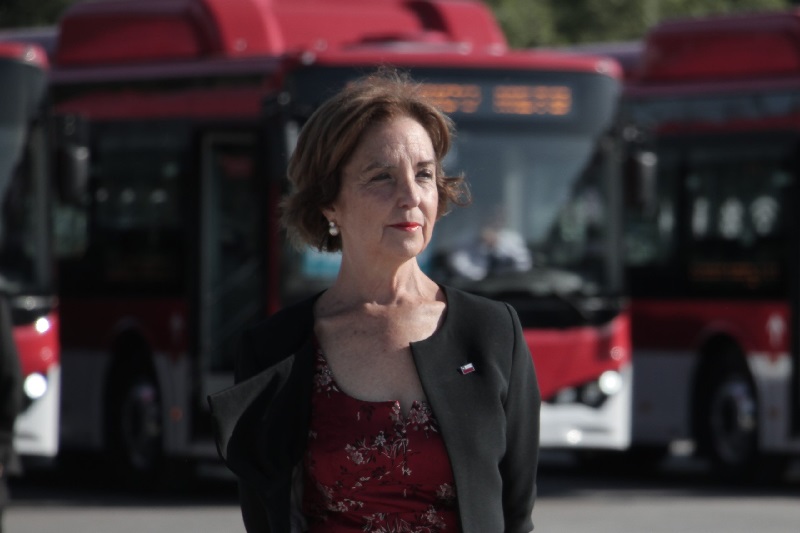“We had to seize this opportunity. We presented it to President Piñera, who was very enthusiastic because he liked technological and innovative changes, but above all, because in the proposal we presented to him, there was no use of additional resources,” explains Gloria Hutt, former Minister of Transport and Telecommunications of Chile, about the financing and engineering model behind the country’s electric bus fleet.
Currently, Chile has more than 2,300 eBuses in operation, making it the Latin American city with the largest fleet outside of China.
“When I took office as Minister in 2018, we proposed that with the same available subsidy budget, we could make a significant change in the transport system,” she states.
However, the story begins in 2007, when the Transantiago project, now called the Metropolitan Mobility Network (RED), was initiated.
This project represented a radical transformation of the transport system, although its start was marked by various complications and a difficult rollout.
“Just when the first cycle of contracts ended, it was time to re-tender, and one option was to maintain the same model that had reasonably stabilised,” Hutt indicates.
However, the tender faced an unexpected obstacle.
The Tribunal for the Defence of Free Competition objected and suspended the process due to a competition concern: two of the bidding companies had a person in common.
That was the trigger that created an opportunity to reconsider and redesign Santiago’s public transport model.
Amid this scenario, the previous administration, led by then-Minister of Transport and Telecommunications Paola Tapia, had begun exploring the viability of electric buses, with the arrival of the first unit to Chile.
Later, another operator brought two additional vehicles.
That tender established a cap of 90 electric buses for the entire city of Santiago, with 15 per unit and six business units in total, totalling 90 buses.
“We saw an opportunity not only to increase the coverage of electric buses but also to change the business model structure that had supported public transport until then,” Hutt comments.
The Chilean public transport system had a significant subsidy that financed approximately half the cost, but the operation was tied to the ownership of the terminals and buses.
This model presented a difficulty since the strategic assets in the operator’s hands gave them power, and if the operator performed poorly, the contract could not be terminated without leaving a significant part of the city without service due to the large size of the business units.
This left the State “captured” by the operator.
“There were several reasons why it was worth evaluating whether to continue with that suspended tender on the same terms or return the offers presented up to that point and reformulate the model,” she says.
Finally, they dismissed the suspended tender and seized the opportunity to reformulate the model with the same available subsidy budget.
What did it mean not to use additional resources to finance the electric bus fleet?
The first thing that was done was to design a new structure for the transport system.
“This may seem anecdotal, but for most people who use public transport, organising it might seem intuitive and easy to opine on. However, the distribution and selection of buses is a branch of transport engineering,” emphasises the former minister.
When presenting her proposals to Piñera, she received creative suggestions, although adjusting those details meant reformulating the entire design.
“Fortunately, the president always offered his support,” she adds.
“What we did was a structural redesign of the contracts with the main objective of being able to control the system based on service quality variables. This meant that the control of strategic assets had to be in the hands of the State, not as property, but as control,” she details about the beginning.
As a result, some terminals were expropriated, others leased, and some purchased, but all came under the control of the Transport Authority.
At the same time, the bus tender was carried out through a leasing system for the lifespan of the buses, separating the operation from the ownership of the assets. The operation focused solely on running the buses.
Hutt explains it this way: “What’s the advantage of that? There are many operators in the market, and not having to take on the strategic assets, they don’t need the financial backing that reduces the offer. Because if we need operators who can also finance the buses and terminals, the pool of candidates shrinks considerably, but if they only have to operate, there are plenty.”
In this way, the contracts were smaller and shorter, reducing the risk. That means that if an operator performs poorly, they can be easily replaced.
The contracts were initially for five years, with the possibility of extending to ten if the established service quality levels were met.
This reformulation was a substantial change, so new contracts had to be created.
A key element during the transition was that, while preparing the new bidding scheme, which was the latest one done, the transition from Transantiago to the new contracts had to be managed, which were temporary renewals until the final tender.
During the temporary system renewals, incentives for electric buses were applied for the first time.
This meant that the operator had a contract with the State, which specified that a subsidy was granted per passenger transported, per kilometre travelled, and other additional payments for operational variables and fleet amortisation.
“What we did was use the fleet amortisation component as a guarantee in the financial system for the use of electric buses,” she expands on the incentives.
The operator took on a crucial part: facilitating financing.
The first operator to do so partnered with an electric company, which built the facilities for electric supply. Thus, they committed to purchasing the first buses and enabling the electric terminal.
An electric bus manufacturer, which was the first consortium formed, took on the financing of the electric fleet. “It was very beneficial because, with the same money, we could start massively renewing the electric fleet,” she adds.
Thus, the first 100 buses arrived in a consortium that included BYD, Enel, and the operator Metbus.
With that trio working, two other similar consortia were formed with different operators, electric suppliers, and bus manufacturers. This allowed the massive arrival of the electric fleet.
“The electric fleet was so well received by the public that it became an incentive because it showed excellent economic performance: the cost went from 380 pesos per kilometre in diesel energy to 70 pesos per kilometre in electric energy,” she states.
The higher investment cost was quickly amortised due to the high mileage of the buses.
“All the pieces fit perfectly, and we achieved our public policy goal: retaining public transport users, especially in a city like Santiago, where the proportion of people using public transport is high by global standards,” she reports.
For this reason, they modernised their fleets with over 90 modifications, including air conditioning, universal access, phone chargers, free Wi-Fi, and an attractive interior and exterior design.
“This mechanism allowed a transition from the expiration of the Transantiago contracts to the start of operations with the new tender,” she comments.
The absence of emissions and noise from electric buses facilitated their integration into urban areas without causing disturbances to residents, improving the physical distribution of the terminals.
Hutt details that they incorporated 800 electric buses through this mechanism and another 1,200 through the latest tender process, reaching a total of 2,000 electric buses.
To learn more about electromobility in Latin America, visit Mobility Portal Latinoamérica







